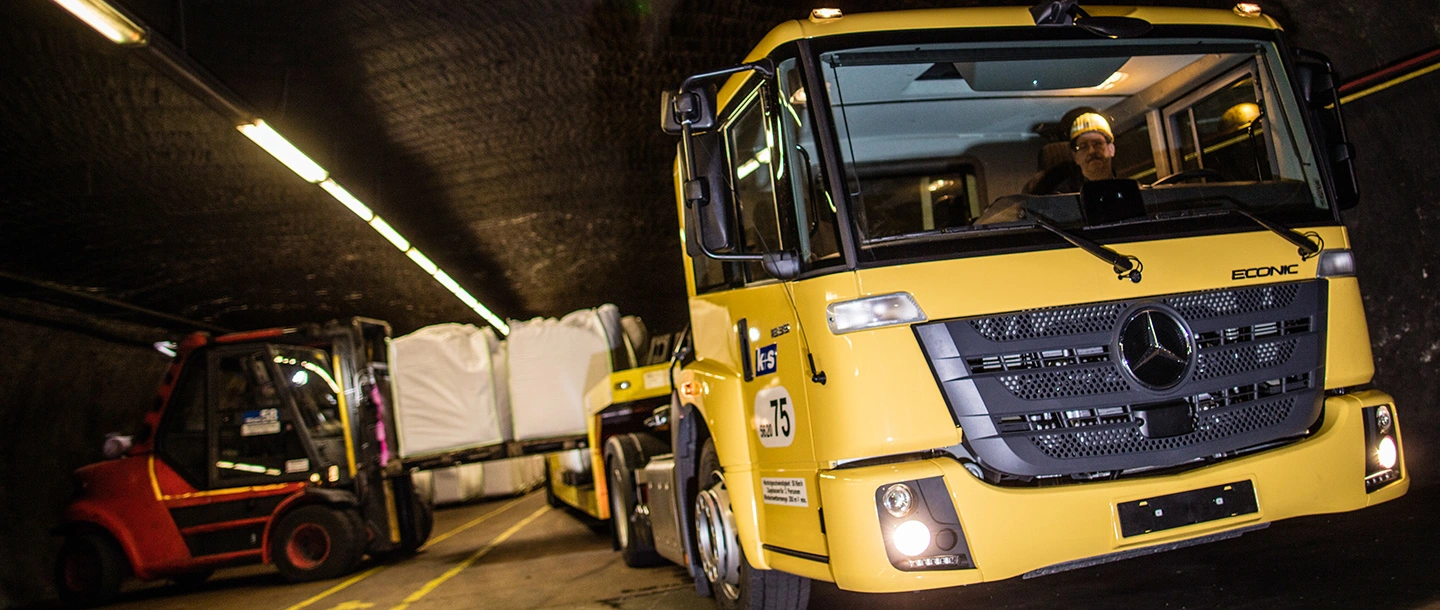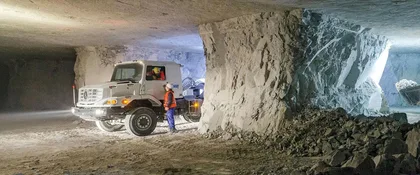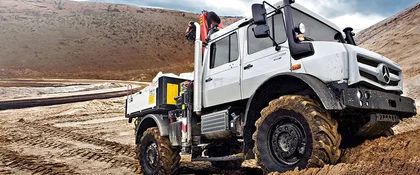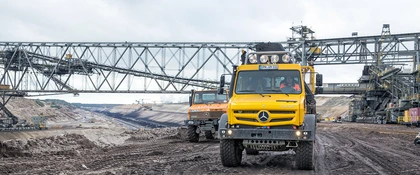Underground salt mining at the Werra potash mine.
For over 125 years, K+S has been extracting and refining mineral raw materials. This enterprise steeped in tradition, deploys the Econic to secure its minefields in the East Hessian potash mining industry.

Around 20 million tonnes of crude salt are mined every year.
The shaft is narrow, the way down below ground gloomy and oppressive. The metal cage measuring just under two and a half by three metres shoots down into the depths at over than eight metres per second, and past millions of years of geological history. After a descent of about one and a half minutes the cage reaches its destination: the first level of the K+S Werra potash mine – 750 metres below the earth's surface.
"Everything we need down here enters through such a narrow shaft," explains Arnd Schneider. "The Econic, too, was brought into the mine like this."47-year-old Schneider has been operations manager at K+S's underground reutilisation facilities at the Hattorf site since 2013.The plant is located about 50 kilometres north of the baroque town of Fulda and is part of the Werra complex. The huge potash mine with its production sites in Hattorf and Wintershall in Hesse and Unterbreizbach in Thuringia extracts around 20 million tonnes of crude salt every year. In addition to fertilizers, the combined plant produces technical salts and high-purity products for the pharmaceutical, food and animal feed industries. K+S is the world's largest salt producer and is among the top international potash suppliers.
The salt is found in two seams at a depth of up to 1000 metres.
"The potassium deposits here in the Werra valley were formed over 200 million years ago through the evaporation of the primeval Zechstein sea", says Arnd Schneider. "Relatively flat potash deposits, so-called beds, with a thickness of only two and a half to four metres contain the crude salt that we extract here." They are located on two horizons or seams at depths of up to 1000 metres. Potassium salts have been mined in East Hesse for over 100 years; nowadays it is done with special large-scale machinery and modern technology. Over the course of many years a mine complex of gigantic proportions was formed. "The Werra site covers approximately the same area as Munich and its suburbs," explains mining engineer Arnd Schneider, a graduate of the Technical University of Freiberg.
The entire K+S Werra plant employs around 4400 people, around 2000 of which are miners. 50 of these are employed in the so-called underground reutilisation, the area for which Arnd Schneider is responsible. Their mission: securing old, already mined, fields. "In some restricted areas of the mine we store mineral waste as backfilling material. This has two advantages: Firstly, they are stabilized by storage and in the second place, we use the material properties of industrial waste products.“, says operations manager Schneider. The backfill material, mostly the finest filter dusts from high-temperature incineration plants, is delivered in silo trucks or in big bags at the Hattorf site. A special conditioning plant prepares for backfilling the waste which can be conveyed by compressed air. Filled into new big bags, the mixture hardens very quickly. These bags, weighing up to 1.2 tons, then reach the mine via the shaft.
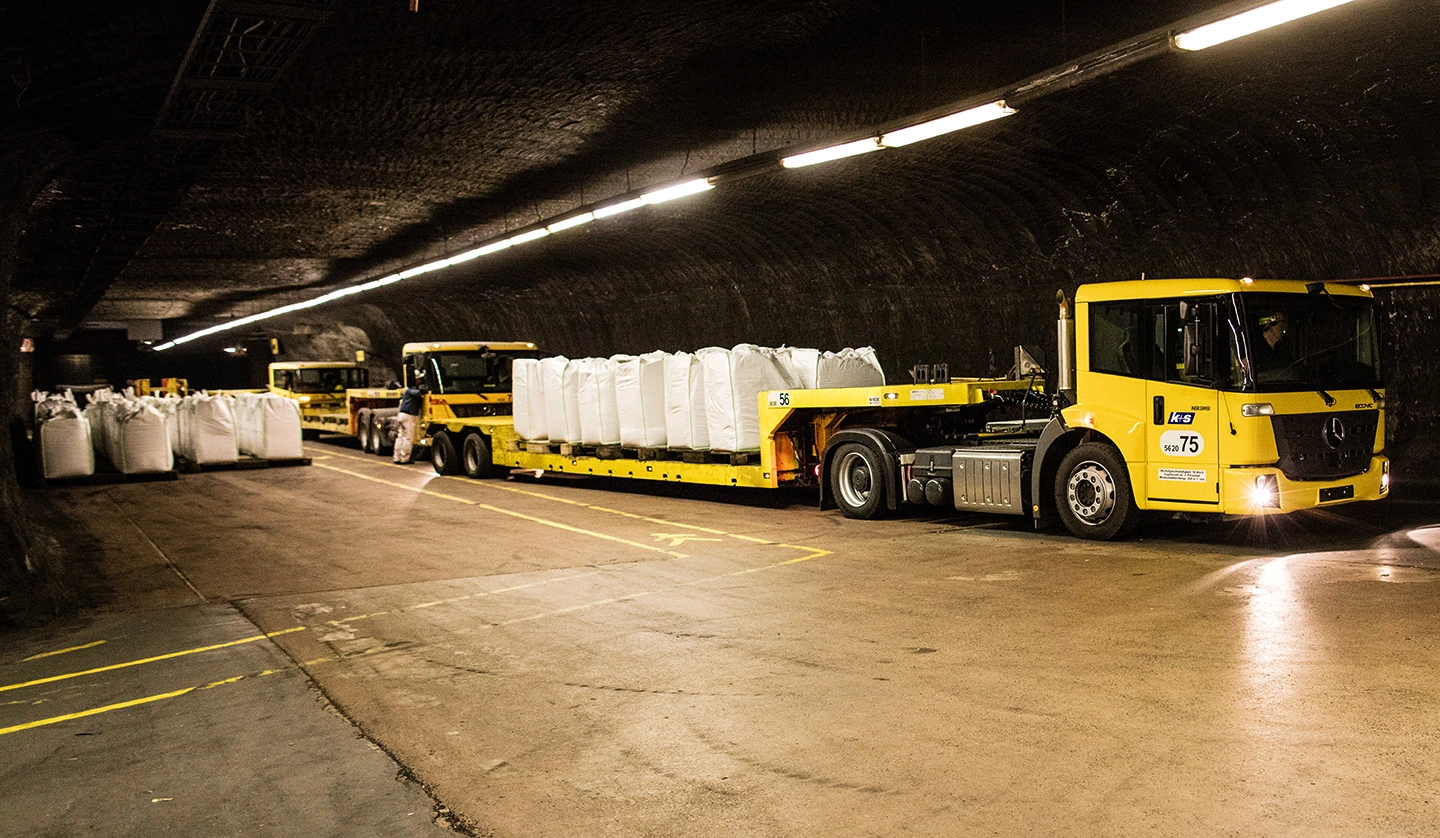
Powerful and comfortable.
More than 1.5 million tonnes of backfilling material has already been placed there. "Here at the bottom of the shaft, we receive the big bags", says Mario Christ. "With the forklift we load up to 16 of them onto the flatbed of my Econic. Then I drive it to the backfill area." The 48-year-old operator has been on the payroll of K+S since 1992. Ever since underground reutilisation started in 1994 this miner has been part of the team. Working around the clock in three shifts, six days a week, he and his colleagues use telescopic stackers and the Econic to store the big bags in the old potash mining caverns: Row by row. Empty spaces are filled in with the help of a reconverted snow blower and fine salt.
Arnd Schneider explains the difficulties of underground mining: "Our challenge: We have to transport loads of around 20 tonnes and overcome slopes of up to 14 percent. This is only possible with a compact little power pack like the Econic 1835." The tough OM 936 Euro VI engine delivering 260 kW has sufficient reserves – enough to tackle steep gradients. It is equipped as standard with full air suspension. The level regulation of the two-axle vehicle can be adjusted individually, for example in order to adapt to the often adverse road conditions on the salt tracks in the mine.
Inside the mine we have an average ceiling height of less than three metres. Normal trucks simply do not fit in here.
Arnd Schneider, Manager, Underground Reutilisation at Hattorf site
Function
High pulling power combined with compact exterior dimensions and low vehicle height – the Econic semitrailer pulls heavy loads though the narrow, steep galleries of the potassium mine.
Equipment
The six-cylinder inline OM 936 engine draws 260 kW from its 7.7 litres displacement.
The frugal Euro VI unit thus offers sufficient power reserves for demanding tasks – including those it tackles deep under the surface of the Earth.
Effect
In the potassium beds of the K+S Werra mine gradients of up to 14 percent can be encountered. The Econic 1835 does not become breathless and can nimbly transport a heavy tonnage of backfill material to secure the pits.Thanks to its outside height of only 2380 millimetres it can be deployed virtually everywhere in the mine.
Pulling a full load the Econic can still manage a speed of 50 km/h.
The gaps between the Big Bags are filled with fine salt.The vehicle, with its external height of just 2380 millimetres, can be lowered by up to 50 millimetres if the going gets too tight because of the low gallery ceiling. The two newest of a total of 13 Econic used in underground reutilisation by K+S, were only slightly modified for working at depth. "We installed a rear window, a cooling unit on the driver's side had to be raised a few centimetres, and the exhaust system moved up behind the passenger side." explains manager Arnd Schneider. Only the trailers had to be specially designed – standard trailers according to DIN would not fit.
Miner Mario Christ likes his new tool: "The Econic has the compact dimensions of a special mining machine, but is much more comfortable.The Allison 6-speed automatic transmission is easy on your nerves, while the air suspension protects your back." Thanks to the powerful engine and robust retarder installed in the Econic 1835, even pulling a full load it can manage a speed of 50 km/h in the extensive underground road network. "You get a lot more done every day than you used to." says Mario Christ. "An engine power increased by more than a quarter but at the same time lower pollutant values than the predecessor model mean enormous progress, and not only for us miners."
Source: Transport-Magazin 2/2016
Text: Christian Schmidt
Photos: Alex Kraus
